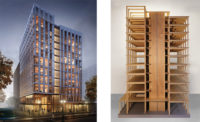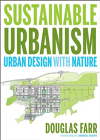As part of the Chicago Architecture Biennial’s kickoff last month, Rural Urban Framework (RUF), a Hong Kong–based nonprofit design lab run by architects Joshua Bolchover and John Lin, was awarded the 2015 Curry Stone Design Prize. The annual award, which honors socially engaged design, celebrates RUF’s commitment to reinvigorating Chinese villages that have been destabilized by unprecedented rural-to-urban migration; more than half of China’s population now lives in cities.
Servicing charities and NGOs, RUF works on projects that vary widely in scale: in some cases they design new housing,and in others they plan entire villages working collaboratively with local residents. Recent projects include Angdong Hospital in Hunan Province, which sought to develop a model structure for rural health care, and an expansion of the Mulan Primary School in Guangdong Province.
RECORD caught up with the 2013 Design Vanguard firm’s two founders about their latest endeavors.
You’ve said that the rural is actually at the front line of urbanization. Can you explain?
Joshua Bolchover: When we started RUF, we realized that we weren’t dealing with purely rural areas but a very volatile landscape that had many types of pressures exerted on it, from economic changes, land-use policies, regulations, and how people were utilizing their land. We came to the realization that we weren’t really working in the rural but on this front line in the urbanization process itself.
John Lin: We’re not rural architects. We’re urbanists. We’re interested in this drive to build and to urbanize.
Your current project in the Sichuan Province’s Jintai Village aims to create a prototype for earthquake reconstruction. Tell me more about it.
JL: We are designing and rebuilding the entire village. We’ve never really done that before; it’s always been an insertion into a larger context. It’s both exciting and kind of frightening.
After the 2008 Sichuan earthquake, the village was in the process of rebuilding its houses. But right before they moved in, there were aftershocks and the houses collapsed again. With the responsibility to build these homes, there’s also an opportunity to improve them and to think about what it means to be a village, what it means to have a shared economy and a shared social engagement.
You’ve recently expanded your research and design work to Mongolia.
JB: The Mongolian project is very different from our work in China. In China, you can say it’s about the process of urbanizing the rural, whereas in Mongolia, it’s really about the effect the rural citizens are having on the city. Rural citizens who migrate into the city are beginning to form informal settlements, which are expanding at the periphery of Ulaanbaatar. We’re coming up with design prototypes for new infrastructure, community services, and housing. We’ve already completed a project in these communities, a combined waste-recycling center and collection facility.
How have you dealt with policy changes and escalating migration into cities since you established RUF in 2006?
JL: When we got involved, China had been urbanizing for a good 30 years. You could say we came in at the tail end of this drive, but it was also the beginning of the Chinese government saying, ‘Okay, we're going to continue this process.” Nowadays, the government has shifted its focus towards the rural. It’s developing the rural, I think, as a backup plan—as a buildup of domestic consumers. It’s been quite a dynamic transformation.
Since you work pro bono, you’re responding to a lot of different agendas and needs. How do you make sure everyone’s interests are met?
JL: The difficulty and the magic happens when you unify a lot of different agendas; I think the architect’s desire is to put all of this into a single form. A project satisfies lots of agendas, but it comes together as a monument to that process. We very much think of our- selves as architects, instead of getting overinvolved in the social, political, or economic issues. It’s still very much about form—solving things through space.
You are both associate professors at Hong Kong University. How do you apply RUF’s goals to your teaching?
JB: We operate as a lab within the university, and we employ people to be our research and architectural design assistants. This year, I’m doing a master’s studio on Mongolia, so the students will participate in the project. John is working on a Chinese village project with his students.
JL: There’s been a lot of currency given to the idea of the research studio, but I think that if you have a parallel goal, which is to actually make a project at the end of the day, it gives that studio more drive—more sharpness and purpose.
















